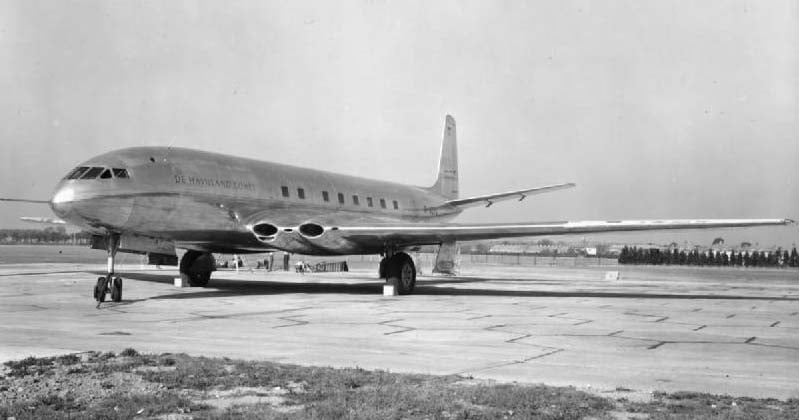*Image Credit: Wikimedia Commons Few advancements of the 20th century have done more to shrink the world than the jet engine, a piece of technology which successfully lifted the first prototype airliner off the ground on July 27, 1949. Britain’s de Havilland Comet, an airframe six years in the making, spent a half-hour in the air above Hatfield and initiated the age of fast, high-altitude travel that now makes it possible for travelers to be on the other side of the planet in just a matter of hours. The Comet 1’s sleek design, a slender fuselage with wings swept back at a 20-degree angle, ended up being the fourth iteration of the aircraft requested by the Brabazon Committee. Formed by the Cabinet of the United Kingdom, the task before them involved analyzing and planning for the airliner’s future in the country after World War II. The possibilities created by the advent of the turbojet seemed illusory, at best – most believed the engines were difficult to maintain and burned too much fuel. Sir Geoffrey de Havilland, feeling strongly these misconceptions could be disproved, successfully lobbied the committee to specify the new aircraft should be jet-powered and won the production contract for the Type 106 – renamed the DH 106 – in February 1945. According to the Brabazon Committee’s recommendations, the first aircraft built should be a small mailplane capable of crossing the Atlantic at 400mph with a one-ton payload. Before long, the six-person design faced its first major change: the plane would have to carry 24 passengers over long ranges. The resultant Type IV of the DH 106 design family was far more expensive and, due to the novelty of the plan, filled with risk. Undeterred, the British Overseas Airways Corporation (BOAC) placed an order for the first ten production models in December 1945. An official design team went to work in February 1946, then faced revisions six months later when the BOAC decided a 36-seat airframe would be better. In order to accommodate the larger fuselage and heavier wings, four powerful Rolls-Royce Avon engines were buried in the wings. Late in 1947, the DH 106 received its official designation – Comet – as the de Havilland company focused on research and development for 1948. Testing the pressurized passenger compartment and steel construction, engineers put the equivalent of 40,000 hours worth of flight time on the testbed. Finally, after more than two and a half years of work since the final Type V design was approved, the prototype left the ground at Hatfield Aerodrome in Hertfordshire on July 27, 1949 piloted by John Cunningham with a four-person crew. It wouldn’t be until January 1952 that the first of the production aircraft would receive the Certificate of Airworthiness, though the government approved the airframe six months ahead of schedule. Just over three months later, the first flight with fare-paying passengers carried travelers from London to Johannesburg on May 2, 1952. Those fortunate enough to afford a seat on the Comet were mesmerized. With an operational ceiling of 42,000 feet, the plane could fly above the weather systems that plagued propeller-driven aircraft. And, with a top speed of 490mph – at least 50 percent faster than the competition – passengers would arrive at their destinations in a significantly shorter amount of time (as much as 50 hours, in some cases). Despite popular acclaim, the Comet 1 was not without its issues. In October 1952, less than six months after the first passenger-filled flight, a BOAC aircraft failed to take off as it reached the end of the runway in Rome. The following March, a Canadian Pacific Airlines flight carrying cargo experienced the same problem in Karachi, killing the five crew and six passengers on board. Then, on May 2, 1953 – a year today after the first flight with people who had purchased tickets – 43 passengers and crew were killed in Kolkata when a BOAC encountered bad weather six minutes after lift off. The Courts of Inquiry that followed, one in India and two in Britain, revealed a structural issue created by the square windows on the side of the fuselage. The oval-shaped portholes on today’s airliners are a direct result of the testing done: there is less stress placed on the hull when at high altitudes, preventing the catastrophic failures that would end up grounding Comet 1s for modification and forcing manufacturing changes to the Comet 2. Two years and three versions after the fateful crash in India, the Comet 4 debuted and, when the aircraft resumed commercial flights in 1958, it would go on to remain in service for nearly 40 years.
July 27, 1949 CE – The De Havilland Comet Takes to the Sky
*Image Credit: Wikimedia Commons Few advancements of the 20th century have done more to shrink the world than the jet engine, a piece of technology which successfully lifted the first…
782
